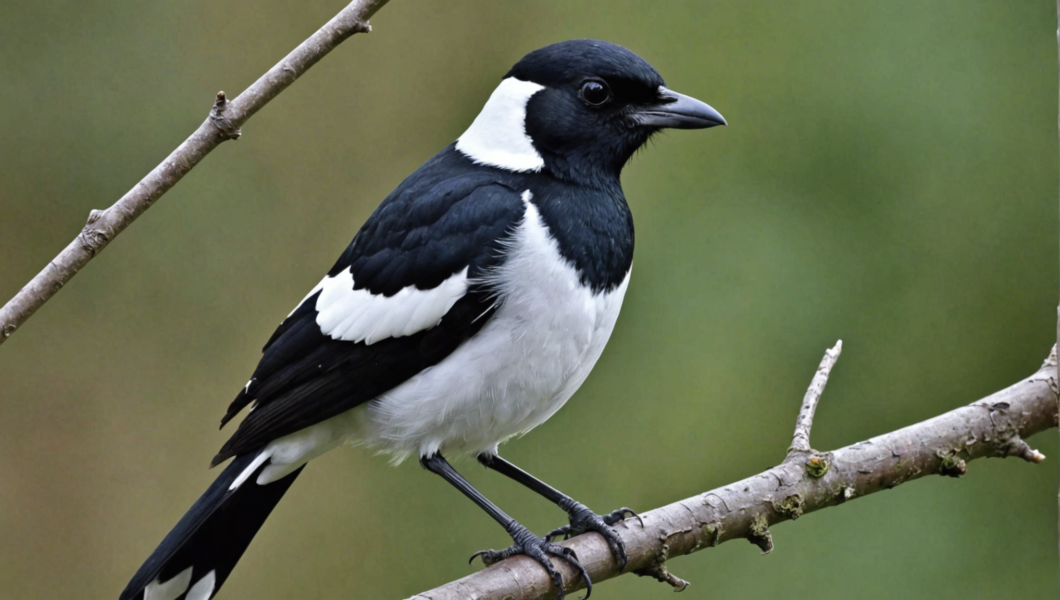About the Chatty Magpie
The Chatty Magpie is a fascinating bird known for its talkative nature and unique black and white plumage. This clever and agile member of the corvid family is often misunderstood and wrongly labeled as a nuisance. In reality, the magpie is simply cunning, resourceful, and well-organized. Despite its loud cries, it is actually a beneficial ally to gardeners, as it helps control pests in the vegetable garden. Let’s take a closer look at this elegant bird that is frequently seen in our gardens.
The Magpie: A Look into its Characteristics
– Order: Passerines
– Family: Corvidae
– Genus: Pica
– Species: pica
The magpie, also known as the Pica pica, is a large bird measuring about 50 cm in length with a wingspan of 56 to 61 cm. Its distinctive plumage is predominantly black with white accents on the belly, flanks, and base of the wings. The black feathers also bear metallic green, purple, and blue hues. These striking color patterns have given rise to the term “magpie” used to describe animals with black and white markings. Juveniles have darker black feathers and their white plumage is tinged with russet.
With its powerful beak and long black legs, the magpie exhibits a unique way of moving by taking long strides and occasionally hopping. Its wings are short and rounded, preventing it from being a skilled acrobat. The magpie is known for its loud chattering and distinctive calls, including the famous “kiah” or “kiak” and the repeated and rapid “tcha cha cha cha chak” sounds. It can also produce a wide range of vocalizations during intimate moments with its mate and family.
A Curious and Cautious Bird
The magpie is a curious and inquisitive bird that often frequents gardens and parks. It can adapt to various green spaces, each with its own unique charm. While exploring these areas, the magpie displays its characteristic swaying gait or jumps on its legs when in a hurry. It retains a certain level of caution when approaching human habitation, quickly fleeing at the slightest sound or suspicious movement. In urban areas, it becomes more accustomed to constant human activity and is generally less fearful, although it still prefers to observe its surroundings from a higher vantage point.
Contrary to popular belief, the magpie is not a thief. Although it may be attracted to objects that catch its attention, it is not interested in stealing gold or jewelry, as often depicted in folklore. Its reputation as a thief stems from misinterpretations of certain behaviors. In the past, tame magpies may have been curious and pecked at shiny human eyes, which raised the misconception of them being thieves. In reality, the magpie is simply investigating its surroundings out of curiosity.
Magpies form long-lasting couples, and once a pair is formed, the male and female stay together year-round, working together in their daily activities. While they defend their territory during the breeding season, the rest of the year is spent in more gregarious groups. Family groups often move together for some time or even tolerate a few marginal individuals. They maintain visual contact while moving more loosely within vegetated areas and rest in groups at night to enhance their protection. In the autumn, younger individuals born that year become restless and eventually leave to establish their own territory.
Habitat and Distribution of the Magpie
The magpie is widely distributed throughout Europe and Asia, from the Atlantic coast to the far east of Russia, as well as in Scandinavia, the British Isles, and the Mediterranean region. It can be found in Sicily and Cyprus, but is absent from Corsica, Sardinia, and Crete. Within this extensive range, there are six subspecies of magpies.
While the magpie initially inhabited mainly agricultural and lightly wooded areas, it has progressively adapted to various open and semi-open terrestrial habitats that offer some woody vegetation suitable for nesting. Dense forests are avoided, and the bird prefers the countryside with its combination of meadows and vegetational partitions. There has been an increasing trend of magpies moving towards urban and peri-urban areas where pesticides, which are detrimental to their food sources, are less prevalent and where they are not hunted.
The magpie seeks refuge in tall trees such as poplars, birches, pines, and cedars, as well as in small woods and groves. Although not demanding, it happily ventures into parks and gardens, as long as humans keep their distance. An estimated 10 to 15 magpie couples can be found per square kilometer on average. The magpie is a sedentary bird and does not usually travel more than 20 to 30 kilometers, except when the young individuals seek available territories.
A Varied Omnivorous Diet
The magpie has an omnivorous diet, feeding primarily on insects, worms, slugs, seeds, and berries found on the ground. It also enjoys human food waste, such as breadcrumbs, eggs, and fruits, and can often be seen scavenging in parks and picnic areas. As a predator and occasional scavenger, like other corvids, the magpie consumes carrion from small animals that have been crushed on roads or fallen victim to agricultural activities, in addition to live prey. Lizards, small amphibians, eggs, and even nestlings of passerine birds are all part of its menu.
Magpies are often found perched on the backs of cows or sheep because they enjoy feeding on ticks that infest the animals’ fur. Another interesting characteristic of the magpie is its ability to dig holes in the ground to store excess food for times of scarcity, demonstrating its foresight and organizational skills.
Reproduction of the Magpie
The magpie’s long-lasting partnerships and sedentary nature result in an early breeding season. The male begins a courtship display in late winter or early spring to attract or reinforce his bond with a female partner, offering her food as a token of affection.
Once paired, the couple devotes several weeks, sometimes up to a month and a half, to constructing a large nest. Interestingly, they build a new nest every year, even though they only rear one brood annually. They carefully select a young tree, typically placing the nest about 10 meters high. In conifers, they prefer the uppermost whorls, while in deciduous trees, the ideal location is at the last fork.
The nest is meticulously constructed with a framework of twigs and woody branches held together with mud. It has a deep interior lined with rootlets for added comfort. On top, the couple builds a dome of prickly branches for protection and creates a lateral entrance.
The female lays between 4 and 9 gray-green eggs speckled with brown, which she incubates for 16 to 21 days while being cared for and fed by her partner. Once the eggs hatch, both parents take on the responsibility of feeding their offspring. The male is particularly attentive and guards the nest, chasing away possible predators to ensure the safety of the young birds. The fledglings leave the nest at around 25 to 29 days old but remain with their parents throughout the summer, only venturing out to find their own territories in the autumn.
The Magpie: Friend or Foe in the Garden?
The magpie is often wrongly labeled as a nuisance in rural areas and classified as a target for hunting. It is frequently accused of raiding the nests of small game birds, other small animals, and mammals, but scientific studies have proven that it does not pose a threat to these species. Aside from its raucous calls, which can be irritating to sensitive ears, the magpie is actually beneficial to gardens, as it helps control many insects that are harmful to plants.
The magpie population is not at risk, and its numbers remain stable despite its undeserved reputation as a nuisance. This resourceful and intelligent bird has adapted well and manages to evade hunters and survive in various environments.
Overall, the magpie deserves appreciation for its role in maintaining ecological balance and its distinctive presence in our gardens.



